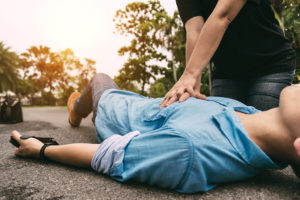
Few Americans survive cardiac arrest when it happens outside a hospital, but if more people knew how to recognize it and do CPR the odds might be better, a new study finds.
Only about 8% of those who suffer a cardiac arrest—a sudden stoppage of the heart—survive. Simply knowing what to do and doing it can increase the chance of survival, researchers say.
Three steps can save lives:
- Recognizing the signs of cardiac arrest—loss of consciousness, no pulse or breathing—and calling 911.
- Beginning cardiopulmonary resuscitation using chest compressions. The American Heart Association recommends using the steady beat of the classic disco song “Stayin’ Alive” as a guide.
- Using an automated external defibrillator to deliver an electric shock to restart a victim’s heart.
Bystanders should start CPR whenever someone is unresponsive and not breathing normally, the American Heart Association advises.
“For every minute that a person with out-of-hospital cardiac arrest goes without CPR and defibrillation, the chance of survival decreases by 7 to 10%,” Dr. William Brady, an emergency doctor at University of Virginia, wrote recently in the New England Journal of Medicine.
A 2010 review of more than 10,000 cardiac arrests found that 22% of patients who received bystander CPR survived, compared with 8% of those who didn’t.
And a 2018 study of more than 50,000 cardiac arrests found that 67% of patients treated with an AED by a bystander survived, compared with 43% of those whose hearts were shocked after rescue crews arrived.
To improve survival odds, more people need to be trained, especially in CPR, the researchers said. Brady estimated that only about 2% of Americans a year get CPR training.
Efforts that might get more people to start CPR early include making training sessions shorter and using smartphone apps to alert trained people to a cardiac arrest near them, he suggested.
“The next major advance in cardiac arrest management is not a new hospital-based treatment nor fire-rescue intervention. It is this pre-arrival care performed by a bystander before fire-rescue personnel arrive and long before a patient is transported to the hospital. This care can allow victims of cardiac arrest to return to their lives and families,” Brady said in a university news release.
 /a>
/a>
 /a>
/a>
 /a>
/a>